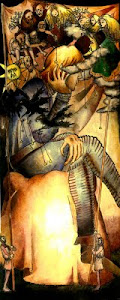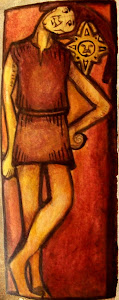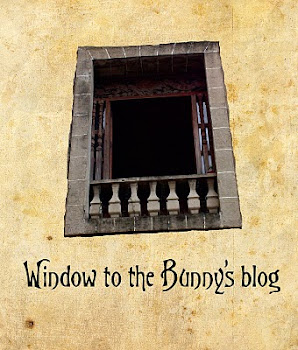Recently, Mama and my sister did a Visita Iglesia, an annual tradition during the Holy Week when people visit seven churches, one after another (though I’m not sure if there will be seven wishes since there is also a tradition of someone went to a particular church for the first time, they could pray for something to be granted unto them). It is somehow connected to the Catholic prayer "The Way of the Cross," in which the devotees reflect and chant a litany that follows the last days of Jesus, also known as The Passion. It's not really for the simply curious, at it IS a pretty long prayer (or, to be correct, set of prayers), involves a lot of kneeling and standing and kneeling. But it's supposed to get you into the Lenten spirit of penance, which, surprisingly, the elderly have the knack in doing. Although you can imagine the pain in the knees afterward. Visita Iglesia is doing pretty much the Way of the Cross, but in seven churches. It's for the faithful alright. In the past centuries, this might have been a whole day affair, that involves walking across seven towns to get this done, and then back home again. Despite not having churches at every town anymore, this tradition had been cut to a half day affair since there is, of course, the comforts of modern traveling in between. (The bunny says, in Compostela, aside from going to the big cathedral, this would have been fairly easy since you'd come across a church within 10 minutes of walking inside the Old Town, which she hunts down for their grotesques and Spanish altars, the retablos. I wonder if she'll record her church hunting soon.)
As you know, I like old churches. And I sometimes imagine myself waking up in the morning with the ringing of old bells in the distance from an old church in a hill, surrounded by trees and green fields. Anyway, back to the church visits, the ones my mother and sister visited, most of them are quite old (and somehow it is quite unfortunate that I didn’t come with them).
As you know, I like old churches. And I sometimes imagine myself waking up in the morning with the ringing of old bells in the distance from an old church in a hill, surrounded by trees and green fields. Anyway, back to the church visits, the ones my mother and sister visited, most of them are quite old (and somehow it is quite unfortunate that I didn’t come with them).
This is a picture of one of the church façade doorways, with a curious masonry emblem as the keystone. Probably it is that of one of the donors to this church, or that of the order who oversaw the church. Mama told me that this edifice has very thick stone walls that, according to her, was once a bastion of some sort.
They also encountered some ruins that is long abandoned but almost attached to the main church. Ruins are interesting site that sometimes it fills my mind with such stories behind the ruins. Did they abandon the site? Was it destroyed by fire or earthquake, or bombed in a battle or a great war? Most probably it was not an earlier version of the church, if it was ruined some time ago. If that was the case, the architect would rebuild it directly over the original foundations. It might have been the convent connected to the church. Traditionally, the residence of the priest and his staff is housed beside it, for convenience's sake, clearly.
Along their way, they also passed by at an old cemetery of priests and some rich people near the place. Each church they visited has its own story, though most of them now forgotten among the ruins or in the dark halls of the large stoned place of worship.
***
And speaking of dark halls and thick walls, I would also like to show you another pictures from the bunny in Spain. This is part of her series in Spain. You might wondering why I am the one who is blogging her stories there. That is because the Bunny is one of the most infrequent bloggers. And, believe me, every work she does, whether pencil drawings or paintings or stories--even our art projects (which she nearly had reductions in everything due to late submission)--she takes long, long hours, days, months, or years to complete. But despite that, these works are worth waiting for. :)
In her very long stay in Santiago, from her room's window, she could see a small former Romanesque hermitage, and later monastery, called Pazo de San Lorenzo. It is once belonged to the line of the Counts of Altamira, who delegated a Franciscan order to run it, she is not sure what it was before since it is always closed. She watches over it during night time, when the night lights would open. And during 12 to 6 am, hourly, it would ring. Like I told you about the bells in the morning, she experienced it there, listening to the small bell ringing from the isolated tower there. Perhaps the present owner still wants to continue the medieval tradition of bell ringing during morning. And it is now open for wedding events, but she conjectures it might be for the elite only, since she never sees their gates open, not even for the church. But she swears it is active. That Easter, it rang from early morning until a few hours later non-stop.

Such monastery stories are also not new to me. I studied in a Catholic school during my high school years and there is also monastery there. If you could walk there the small quarters, it is seemingly unoccupied. And interestingly, you can see from the distance the old city of Santiago, with the beautiful church looming through its towering structure.
***
Recently I finished a new painting. I will show to you probably on my next post since I had it scanned in one of my sister's house, and she is still busy with other things(I do not have a camera this time, which would explain my delay in uploading my artworks).





































No comments:
Post a Comment